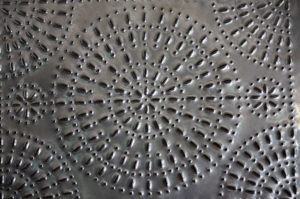-
 According to Old Sturbridge Village “The tin business in New England began in the mid-1700s but grew most rapidly after 1820. Tinware competed successfully with the more traditional products of redware potters. Tin shop owners purchased tinplated sheet iron imported from England, shaped it into a variety of forms, and distributed finished goods wholesale through peddlers and country stores, and at retail from their shops. Pails, colanders, dippers, dish kettles, funnels, measures, and pans of all kinds were in greatest demand. Lanterns, footstoves, teapots, coffeepots, tin kitchens, skimmers, and sconces were other common utensils produced for house, farm, and shop.” At this Art of Tin Punching Workshop for Kids on Saturday, January 11, 11:00 – 12:30, Museum Educator Katherine Karlik will talk about tin punching, and about William and Edward Pattinson, brothers who settled in Connecticut around 1740 and established the first tin shop in America. The workshop project is making a rectangular placard which can be used as a wall hanging, featuring a simple dot and dash design. Children will help make their own snack.
According to Old Sturbridge Village “The tin business in New England began in the mid-1700s but grew most rapidly after 1820. Tinware competed successfully with the more traditional products of redware potters. Tin shop owners purchased tinplated sheet iron imported from England, shaped it into a variety of forms, and distributed finished goods wholesale through peddlers and country stores, and at retail from their shops. Pails, colanders, dippers, dish kettles, funnels, measures, and pans of all kinds were in greatest demand. Lanterns, footstoves, teapots, coffeepots, tin kitchens, skimmers, and sconces were other common utensils produced for house, farm, and shop.” At this Art of Tin Punching Workshop for Kids on Saturday, January 11, 11:00 – 12:30, Museum Educator Katherine Karlik will talk about tin punching, and about William and Edward Pattinson, brothers who settled in Connecticut around 1740 and established the first tin shop in America. The workshop project is making a rectangular placard which can be used as a wall hanging, featuring a simple dot and dash design. Children will help make their own snack.
Suggested for ages 6 – 12. Wilton Historical Society members $10 per child; Non-members $15 per child. Please register: info@wiltonhistorical.org or call 203-762-7257.
Did You Know?
“The tin lanterns that illuminated front porches and parlors throughout Europe can be traced to at least the early 16th century. By the Colonial era, tin punching added a bit of variety to the traditional choices of tin lanterns fitted with panes of glass or cow horn. Lanterns with those original types of panes could still be punched, but tinsmiths might bypass panes altogether if they made enough holes to let sufficient light shine through.” – Colonial Williamsburg website.